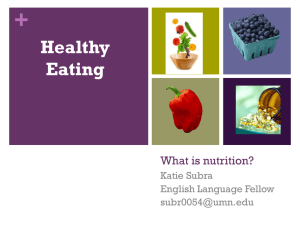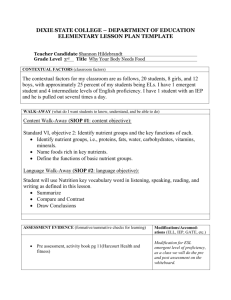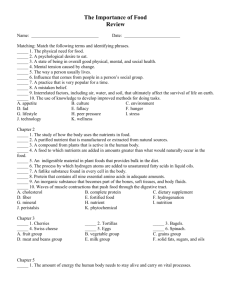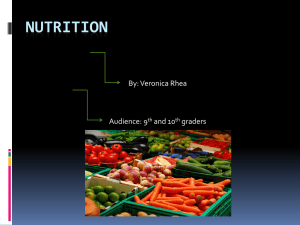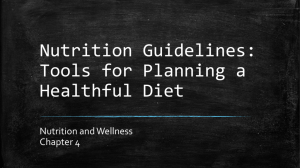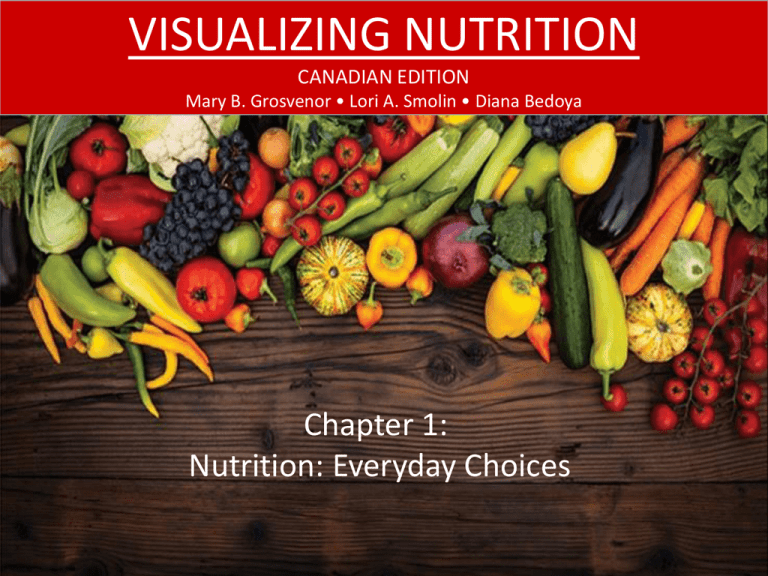
VISUALIZING NUTRITION
CANADIAN EDITION
Mary B. Grosvenor • Lori A. Smolin • Diana Bedoya
Chapter 1:
Nutrition: Everyday Choices
CHAPTER 1: NUTRITION: EVERYDAY CHOICES
LEARNING OBJECTIVES
At the end of this chapter, you should be able to:
• Reflect on factors that influence food choices
• Compare and contrast the 6 nutrient classes
• Describe ways to obtain balance, variety, and
moderation to avoid under- and overnutrition
• Describe how genes and diet interact to promote
health and result in disease
• Evaluate nutrition information and claims
THINK about this – then share within a PAIR
– then SHARE with the class
• What are nutrients? Why do we need them?
• What are the benefits and risks of consuming calories?
• What is one high-calorie food and one low-calorie food
you consumed recently?
Nutrients
• Provide energy (calories = measure of energy)
• Provide structure
• Regulate body processes
• Essential nutrients: our bodies cannot make them, so it
is essential that we consume them
Nutrient Density
• High nutrient density foods: contain more nutrients per
calorie
• Examples: cake, sugary drinks, French fries
• Low nutrient density foods: contain fewer nutrients per
calorie
• Examples: vegetables, fruits, whole-grains
Nutrient Density
Nutrient Density
Apply to your life
• What are examples of low nutrient density foods in
your diet?
• What are examples of high nutrient density foods in
your diet?
• How could you replace high nutrient density foods with
low nutrient density foods in your diet?
Fortified foods
• Nutrients added to foods
• Mandated by the federal government in attempt to
eliminate nutrient deficiencies in Canada
• Vitamins and minerals are routinely added to various
foods at the discretion of manufacturers
Dietary supplements
• Supplement the diet
• May include nutrients (vitamins, minerals, amino acids,
fatty acids), enzymes, herbs, or other substances
Concept Check
1. Which has a higher nutrient density, a can of pop or
a glass of milk?
2. Why are foods fortified?
3. Why is it better to meet your vitamin C needs by
eating an orange than by taking a dietary
supplement?
4. What factors determine which foods you eat at a
family picnic?
THINK about this – then share within
a PAIR – then SHARE with the class
• Think about foods you have consumed in the last
week. What influenced your choices?
• What is the strangest food you have consumed (by
Canadian standards)?
• Describe a celebration in your family. Who would be
there? What would you do?
THINK about this – then share within
a PAIR – then SHARE with the class
• What are examples of nutrients?
Six classes of nutrients
•
•
•
•
Water
Carbohydrates
Proteins
Fats
• Vitamins
• Minerals
Macronutrients
Micronutrients
Six classes of nutrients
• Organic compounds: substances that contain carbon
bonded to hydrogen in their molecular structure
• Include: carbohydrates, lipids and proteins
Six classes of nutrients
• Carbohydrates: include sugars, starches, and fibre;
contain carbon, hydrogen and oxygen
• Lipids (fats): include cholesterol, saturated fats,
monounsaturated fats, and unsaturated fats; contain
carbon, hydrogen and oxygen
• Triglycerides, most common lipids are composed of glycerol
and fatty acids
• Proteins: are composed of amino acids; contain
carbon, hydrogen, oxygen, and nitrogen
Six classes of nutrients
• Vitamins: organic molecules needed in small
quantities; play role in regulation of energy production,
maintenance of vision, blood clotting, etc.
• Minerals: essential elements; perform variety of
functions including transport of oxygen (iron), muscle
contraction (calcium), etc.
What are similarities and differences
between:
• Carbohydrates, proteins, fats, water, vitamins, and
minerals?
Examples of nutrients
© Can Stock Photo Inc. / robynmac
• a. Some high-carbohydrate foods, such
as rice, pasta, and bread, contain mostly
starch; some, such as berries, kidney
beans, and broccoli, are high in fibre;
and others, such as cookies, cakes, and
carbonated beverages, are high in
added sugar. Vegetables and fruits are
often overlooked as carbohydrates, but
are excellent sources of carbohydrate
that also provide vitamins, minerals,
water, and fibre. High-fibre, vitamin- and
mineral-rich, low-sugar foods have a
higher nutrient density than do low-fibre,
high-sugar foods.
Examples of nutrients
Tetra Imagers/Getty Images
• b. High-fat plant foods such as
vegetable oils, olives, nuts,
and avocados have no
cholesterol and are high in
unsaturated fat and are not
associated with an increased
risk of heart disease. High-fat
animal foods such as butter,
meat, and whole milk are high
in saturated fat and
cholesterol. Diets high in
saturated fats are associated
with an increased risk of heart
disease.
Examples of nutrients
• c. The proteins we
obtain from animal
foods, such as meat,
fish, and eggs, better
match our amino acid
needs than do
individual plant
proteins, such as those
found in grains, nuts,
and beans. However,
when plant proteins are
combined, they can
provide all the amino
acids we need.
Nutrient functions
•
•
Provide energy (calories)
Provide building blocks for body’s structure
•
•
•
Bones, hair, muscle, skin, etc.
Cellular membranes, other cellular components
Regulate body processes
•
•
•
•
Body temperature
Blood pressure
Blood sugar level
Other
Calorie (with a capital “C”)
•
•
•
•
•
•
Calorie = kilocalorie (kcal) = 1000 calories
Measure of energy in food
Proteins and carbohydrates = 4 kcal/gram
Fat = 9 kcal/gram
Alcohol = 7 kcal/gram (not a nutrient)
Water, minerals and vitamins do not provide energy
(calories)
Nutrient functions
© Can Stock Photo Inc. /KAValles
Phytochemicals and zoochemicals
• Non-nutrient substances in food thought to be
beneficial to the human body:
• Phytochemicals present in foods from plants
(phyto refers to plants)
• Zoochemicals present in foods from animals
(zoo refers to animals)
Phytochemicals
Functional foods/neutraceuticals
• Functional foods: have health-promoting and/or
disease-preventing properties beyond basic nutritional
functions
Examples of functional foods
Designer foods/neutraceuticals
• Functional foods with added nutrients have also been
called designer foods or neutraceuticals
• Examples:
• Water with added vitamins
• Margarine with added plant sterols
• Orange juice with added calcium
Concept Check
1. Which classes of nutrients provide energy?
2. What three nutrient functions help ensure normal
growth, maintenance of body structure and functions,
and reproduction?
Malnutrition
• Malnutrition: a condition resulting from an energy or
nutrient intake either above or below that which is
optimal
• Overnutrition: excess intake of a nutrient, nutrients or
calories
AND
• Undernutrition: inadequate intake of a nutrient,
nutrients or calories
Undernutrition
a. Even though this child looks
normal and healthy, she has low
iron stores. If the iron content of
her diet is not increased, she will
eventually develop iron deficiency
anemia. Mild nutrient deficiencies
like hers may go unnoticed
because the symptoms either are
not immediately apparent or are
nonspecific. Two common
nonspecific symptoms of iron
depletion are fatigue and a
decreased ability to fight infection.
Undernutrition
b. The symptoms of starvation, the
most obvious form of
undernutrition, occur gradually
over time when the energy
provided by the diet is too low to
meet the body’s needs. Body
tissues are broken down to provide
the energy to support vital
functions, resulting in loss of body
fat and wasting of muscles.
Overnutrition
a. Obesity is a form of
overnutrition that occurs when
energy intake surpasses energy
expenditure over a long period,
causing the accumulation of an
excessive amount of body fat.
Adults are not the only ones who
are getting larger. It is estimated
that just over 30% of Canadian
children and adolescents ages 2
to 17 years are overweight.
© Can Stock Photo Inc./stu99
Overnutrition
• The top three causes of death in Canada are nutrition
related. They are all thought to be exacerbated by
obesity
THINK about this – then share within
a PAIR – then SHARE with the class
• What is DNA? Where is it located?
• What is a chromosome? What is a gene?
• How are traits inherited?
Diet-gene interaction
• Diet affects your health but diet alone does not
determine whether you will develop a particular
disease
• Some genes (specific segments of DNA that are
responsible for determining specific inherited traits) can
increase, other decrease your risk of developing
certain diseases
Disease genetics
• Some diseases occur when one gene is mutated
• Examples: cystic fibrosis, sickle cell anemia
• Most diseases result from both genetics and the
environmental influences where genes increase risk
• Examples: obesity, heart disease, diabetes
Disease genetics
Ask yourself
• What 2 factors affect your risk of developing a nutritionrelated disease such as obesity?
• Can you still become obese even if both of your
parents are thin?
Nutritional genetics or nutrigenomics
• The study of interactions between genes and nutrition
• Personalized nutrition: diets based on a person’s
genes
THINK about this – then share within
a PAIR – then SHARE with the class
• A friend of yours wants advice on what to eat as a
healthy diet. What advice would you give?
Concept Check
1. What causes malnutrition?
2. How can your diet today affect your health 20 years
from now?
3. Why might the diet that optimizes health be different
for different people?
Healthy diet
Variety, Balance, Moderation
• High in:
• Fruits, vegetables, whole grains
• Moderate in:
• Calories, sodium, sugar
• Low in:
• Unhealthy fats (trans fats, saturated fats, cholesterol
Variety
• Eating foods from a variety of food groups
• Eating a variety of foods within each food group
• Benefits: increased nutrients and phytochemicals,
decreased toxins
Balance
• Balance less healthy foods with healthy ones
• Balance calories intake with calories burned
• Balance diverse foods within food groups
• Benefits: wider variety of nutrients and weight control
Moderation
• Moderate portion sizes
• Moderate consumption of fat, sugar, and sodium
• Moderate calories intake
• Benefits: not too much of any nutrient or calories
Healthy diet
Andy Washnik
© Can Stock Photo Inc. / monkeybusiness
Andy Washnik
© Can Stock Photo Inc. / charlesknox
Apply to your life
• What are examples of balance, variety, and moderation
from your diet?
• How you could improve your diet?
Concept Check
1. Why is variety in a diet important?
2. How might you balance the 600-kilocalorie
Cinnamon roll you had for a morning snack with your
lunch choice?
3. What is the connection between obesity and
moderation in a diet?
Healthy diets & recommendations
are based on research
• How are studies conducted?
• How do we know which information to believe and
which advice to follow?
Science of nutrition–scientific
method
1.
2.
3.
4.
5.
6.
7.
Make an observation
Propose a hypothesis
Design & conduct experiment to test hypothesis
Analyze results
Publish & present with peer review
Repeat and expand experiments
Develop theories based on results from many
experiments
Science of nutrition–scientific
method
Apply to your life
1. Make an observation
example: I received 3 compliments on my hair cut
2. Propose a hypothesis: make a prediction based on
your observation
example: my hair looks good when it is short; it will look
better if it is even shorter
3. What information would you need to test this
hypothesis? How could you gather it?
example: cut hair shorter and record comments
Apply to your life
1. Make an observation about college student nutrition
habits
example: there is a lot of bottled water in class
2. Propose a hypothesis: make a prediction based on
your observation
example: college students drink more bottled water than tap
water
3. What information would you need to test this
hypothesis? How could you gather it?
Science of nutrition-types of studies
• Epidemiological: studies populations
Example: consumption of fish & heart disease in Japanese
people versus North Americans
• Experimental: compares an experimental group with a
control group
Example: experimental group drinks takes supplement and
control group takes placebo
• Laboratory: cells, animals, or humans are studied
using biochemistry and molecular biology techniques
within a laboratory
Example: food administered and blood glucose tested
Science of nutritionepidemiological evidence
What are similarities and differences
between:
• Hypothesis and theory?
• Epidemiological, experimental, and laboratory studies?
• Experimental group and control group?
Types of nutritional information
Types of nutritional information
© iStockphoto.com/Koe Cicak
Limitations of nutritional studies
Questions to ask about nutrition data
1. Does it make sense?
2. What’s the source?
3. What evidence is being presented?
4. Is it selling something
Debate
How involved should the government
be in your food choices?
Concept Check
1. What is the difference between a hypothesis and a
theory?
2. How is epidemiology used to study nutrition?
3. Why are control groups important in any scientific
experiment?
4. Why is information in advertisements likely to be
exaggerated or inaccurate?
Checking student learning outcomes
• What influences food choices?
• How are the 6 nutrient classes similar and different?
• How can you obtain variety, balance, and moderation
in your diet to avoid malnutrition?
• Which diet-related diseases run in your family? How
can you modify your risk?
• What questions can you ask to help determine if data
can be trusted?
COPYRIGHT
Copyright © 2014 John Wiley & Sons Canada, Ltd.
All rights reserved. Reproduction or translation of
this work beyond that permitted by Access Copyright
(The Canadian Copyright Licensing Agency) is
unlawful. Requests for further information should be
addressed to the Permissions Department, John
Wiley & Sons Canada, Ltd. The purchaser may make
back-up copies for his or her own use only and not
for distribution or resale. The author and the
publisher assume no responsibility for errors,
omissions, or damages caused by the use of these
programs or from the use of the information
contained herein.

